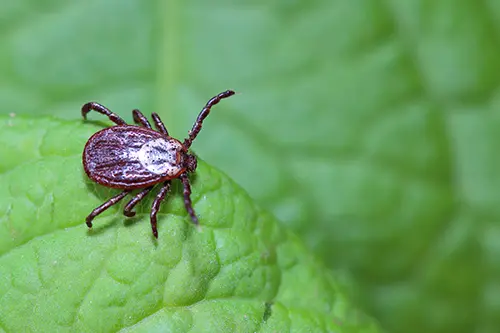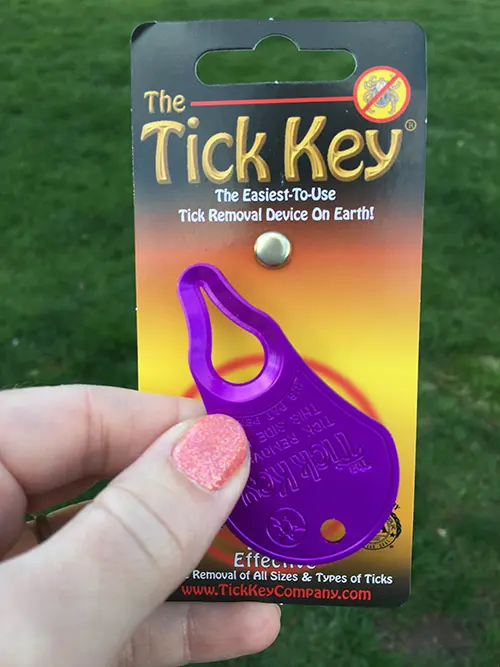
Easy Ways to Keep Ticks Off of Your Dachshund
Did you know that ticks pose a year-round threat to both you and your Dachshund?
To protect our doxies, it’s crucial to understand the dangers that ticks present and to learn the most effective prevention methods.
Discover how to keep ticks off of your Dachshund and ensure their safety.
This page contains affiliate links and I earn a commission if you make a purchase through one of the links, at no cost to you. As an Amazon Associate, I earn from qualifying purchases.
Table Of Contents
What Is A Tick?
Ticks are not insects! They are actually small arachnids (spiders). Adult ticks have eight legs, a round-shaped body, and are usually 3 to 5 mm in length. They can be brown, black, or tan in color. Ticks are ectoparasites, which means they live off of the blood of other animals, people, birds, reptiles, and amphibians.
TICK FACT #1: There are 200 known Tick species located in the USA.
Ticks are usually found in forests, meadows, parks, and gardens. They can attach to you or your dog just by brushing up against them. Dogs can pick up ticks while walking through tall grass or crawling through shrubs.
Female ticks will lay their eggs under sheltered areas in your yard, such as wood stumps or rocks. Once hatched, the larvae (called seed ticks) will crawl up grass stems or bushes and attach themselves to your dog’s fur if he passes by.
TICK FACT #2: A female tick can lay between 3000 to 7000 eggs in one sitting.

What is the Difference Between Fleas and Ticks?
Fleas can jump, but Ticks crawl and climb. Ticks will remain in place while feeding and may not cause a lot of itching (which makes them harder to find). Fleas cause hot spots, while ticks cause illness.
TICK FACT #3: Ticks can swell up to 10 times its normal size from the blood it consumes.
Why You Can’t Feel A Tick Bite
When a tick has found a host to feed on, they will usually search for soft warm place on the skin with little to no hair to latch on. When they bite, they secrete a numbing chemical so that the host doesn’t feel their mouth-parts cut through their skin.
The tick inserts a feeding tube and feeds on blood until it is full. Their mouth-parts are barbed so that your dog can’t scratch to get rid of the tick. When the tick is full, it will fall off on its own.
All tick bites should be taken seriously. It may take several hours to transmit a tick-borne disease to a host. The sooner a tick is located and removed, the lower the risk of a transmitted disease. 1
TICK FACT #4: A tick’s saliva contains so much bacteria that they are among the most potent disease carriers in the world.

How To Check Your Dachshund For Ticks?
Finding ticks on your Dachshund is not always easy. Check the following areas on your doxie several times over after spending time outside:
- Under the Tail
- Groin
- Armpits
- Inside and Outside Ears
- Eyelids
- Between their toes
- Face and Chin
Check for any bumps between the size of a pin-head all the way up to the size of a small grape. Shine a light on your dog’s fur (not face) to see if that bump is just a skin tag or a tick by looking for little black legs or reddish looking irritation between the bump and your dog’s skin.
Depending on how long they have been feeding, the tick may or may not be very big.
Note: Remove your doxie’s collar during the tick inspection, ticks could be lurking underneath.
Video You Should Watch: What to Do When Your DOG Has a Tick Infestation on Vacation!
What Diseases Can Your Dog Get from a Tick?
Unfortunately, one tick bite is enough to transmit a life-threatening disease to your dog. The following diseases can affect humans and dogs.

10 Diseases Ticks Can Transmit
TICK FACT #5: Tick infestations are more common in dogs than cats. They are also easier to prevent since there are more FDA-approved products to kill ticks on dogs than on cats. 7
Tick Paralysis in Dachshunds
Now, this is a scary one, especially for our Dachshunds. Dachshunds are prone to back issues, like IVDD. So, if a doxie goes lame one day, most Dachshund owners assume they have a spinal issue.
Not always the case. A tick’s saliva can release several toxins into the bloodstream and cause your pup to become lame!
This is called Tick Paralysis.
Often times, when a dog owner doesn’t see the tick on the dog, they may think that their dog’s paralysis is permanent. What’s worse, some may even decide to euthanize the dog! The good news is usually after the tick has been removed, this paralysis condition wares off. 1
Watch out for Tick Paralysis in Dachshunds!
Post You May Like: How To Avoid IVDD In Dachshunds
Tick Bite Symptoms
Many symptoms of a tick bite may take days or weeks to appear. If your Dachshund has ticks, watch out for the following signs and contact your veterinarian ASAP.
TICK FACT #6: Female long-horned ticks don’t need a male to reproduce. They can spawn asexually and lay thousands of eggs. 6
How To Remove a Tick from a Dachshund
1. Gather Recommended Equipment:
- Rubber Gloves
- Clean Fine-Point Tweezers or Tick Remover Tool
- Peroxide
- Isopropyl Alcohol
2. Wear Gloves:
When removing the tick from your dog, you should wear gloves to prevent the spread of Lyme Disease.
3. Using Tweezers:
- Use fine-point tweezers to avoid tearing the tick and spreading infections into the wound.
- Grasp the tick body as close to your dog’s skin as possible (try not to pinch their skin).
- Firmly pull the tick straight out without crushing or squeezing it – this would release more toxins into your dog’s bloodstream. Note: Tick Remover Tool Directions Below.
4. Kill The Tick:
Ticks can live for months in their surrounding habitat without a blood meal 4. Flushing them down the toilet or attempting to squish them won’t work!
Put the Tick in Isopropyl Alcohol to Kill it.
I usually put some alcohol in a small plastic bag to finish the job. If you would like to hang onto the tick to be tested by your vet, use a glass jar.
Continue to check on the tick bite area over the next few days for infection. Call your veterinarian if you notice any issues. If you find more than one tick while performing your routine tick inspections, ask your vet for a dog flea and tick shampoo recommendation.
5. Cleanup and Disinfection:
Always wash your hands and your dog’s wound with soap and water. Then, gently wipe their wound with some peroxide on a cotton ball.
Peroxide is recommended for tick bites because the oxygen it contains destroys the Lyme Disease bacteria. Lastly, apply an antibiotic ointment to the wound and disinfect your tweezers or tick removal tool with isopropyl alcohol.
Best Tick Removers
Honestly, pulling a tick out of my dog’s skin using tweezers makes a mess. It always ends up leaving the tick head imbedded in my doxie’s skin – which can lead to an infection.
Tick Removal Tools are so much easier to use than tweezers.
Don’t get me wrong, sometimes those nasty tick’s get into a location that is just too hard to reach with a tick remover tool. That’s when tweezers may be the only option for proper removal. In between your dog’s toes or deep in his ear would require some tweezers.
1. The Tick Key
My #1 Choice is the Tick Key (from Amazon). It can attach to your key ring, so you never have to leave home without it.
Simply put the tick’s body through the largest part of the opening in the key, slide it down so the smallest part of the opening is around the tick, and give it a pull.
Dachshund Parents – This tool pulls the entire body and head of the tick out of your dog’s skin!
Add the Tick Key to your Pet Emergency Kit before you go for a hike or play at the park.

2. Tick Twister
With the Tick Twister (from Amazon), you simply put the prongs on either side of the tick and twist upward. It removes the tick without squeezing it, reducing the risk of infection, and doesn’t leave tick head in the skin. The Tick Twister removes ticks in a few seconds without pain.

Amazon
Alternative Ways To Remove A Tick
1. Soap-Soaked Cotton Ball:
The Soap Soaked Cotton Ball method can be used for dogs or humans. This method is more of a “home remedy” that some pet owners swear by. It is a helpful solution for removing ticks that are in those hard to reach spots where tweezers just won’t work.
First, apply some liquid dish soap to a cotton ball. Then, cover the tick with the soap-soaked cotton ball and move it around in circles for about 40 seconds.
The tick should come out on it’s own and be stuck to the cotton ball when you lift it away. If you are afraid you dog is sensitive to some soaps, try using dog shampoo instead.
2. Wet Q-tip Method:
Wet a Q-Tip with clove essential oil. Clove oil is a tick repellent. Rub your oiled up Q-tip in a circle around and around the tick.
This motion will agitate the little critter until it backs out of your dog’s skin. Then, put that little sucker into some isopropyl alcohol to kill it.

If The Tick’s Head Gets Stuck
Even if you try your best to be careful when removing a tick from your dog’s skin, it is common for the tick’s head to get left behind. Continue to keep the wound area clean and inspect it periodically for any inflammation or infection.
Do not try to dig out the rest of the tick from your Dachshund’s skin, you could make the wound much worse than it already is. Generally, your dog’s body will get rid of the tick head naturally, but if it doesn’t, you can contact your vet for help.
How to Kill a Tick
Drop any nasty tick that you find into isopropyl alcohol to kill it! Flushing the tick down the toilet won’t kill it.
Do not squish the tick between your fingers. The tick-borne diseases can be transmitted to you if you touch it, yuck!
Directions: Put the tick in a glass jar or plastic bag. Then, add a teaspoon of rubbing alcohol. The alcohol will kill the tick. Next, write down the date you found the tick. Keep an eye on the area where the tick was to see if an infection surfaces.
If your dog shows any symptoms of illness over the next couple of weeks, take your pup and the tick to your vet for an examination.
TICK FACT #7: Adult Ticks have the ability to survive without a host for up to a year and a half.

How To Keep Ticks Off of Your Dachshund
The Companion Animal Parasite Council says the most important thing to do to prevent ticks is to use a combination flea and tick control agent All YEAR Round.
TICK FACT #8: It takes about 24-48 hours for a tick to absorb a fatal dose of pesticide. After death, some ticks remain attached because their barbed mouth parts don’t detach. 2
Helpful Resources:
References:
- Getting a Tick Off A Dog: Humane Society
- Flea and Tick FAQ: 1-800 Pet Meds
- Tick Diseases: Animal Wised.com
- Schweitzer, Karen. 2010. Our Best Friends: The Dachshund. Pittsburg, PA: Eldorado Ink.
- Pinney, Chris C. 2010, 2000. Hauppauge, NY 11788.
- Longhorned Tick Info: Prevention.com
- Tick Facts: Petmd.com




I had a tick burrow so deep on my doxie that I had to pop it like a pimple expelling puss from infection as well
Hi! Oh wow, Yuk, ticks are so gross. I hope your doxie is ok if there was an infection, poor pup.
What a great comprehensive and informative list! Ticks definitely freak me out. And this year, they are predicting the worst tick season ever here. I just ordered a tick remover and am creating a tick kit that my daughter found online.I am Pinning this to share and hope everyone reads it!
Hello Dorothy, Thank you very much for your comment and sharing my article. Yes, it is helpful to spread this information so everyone is aware and can stay safe.